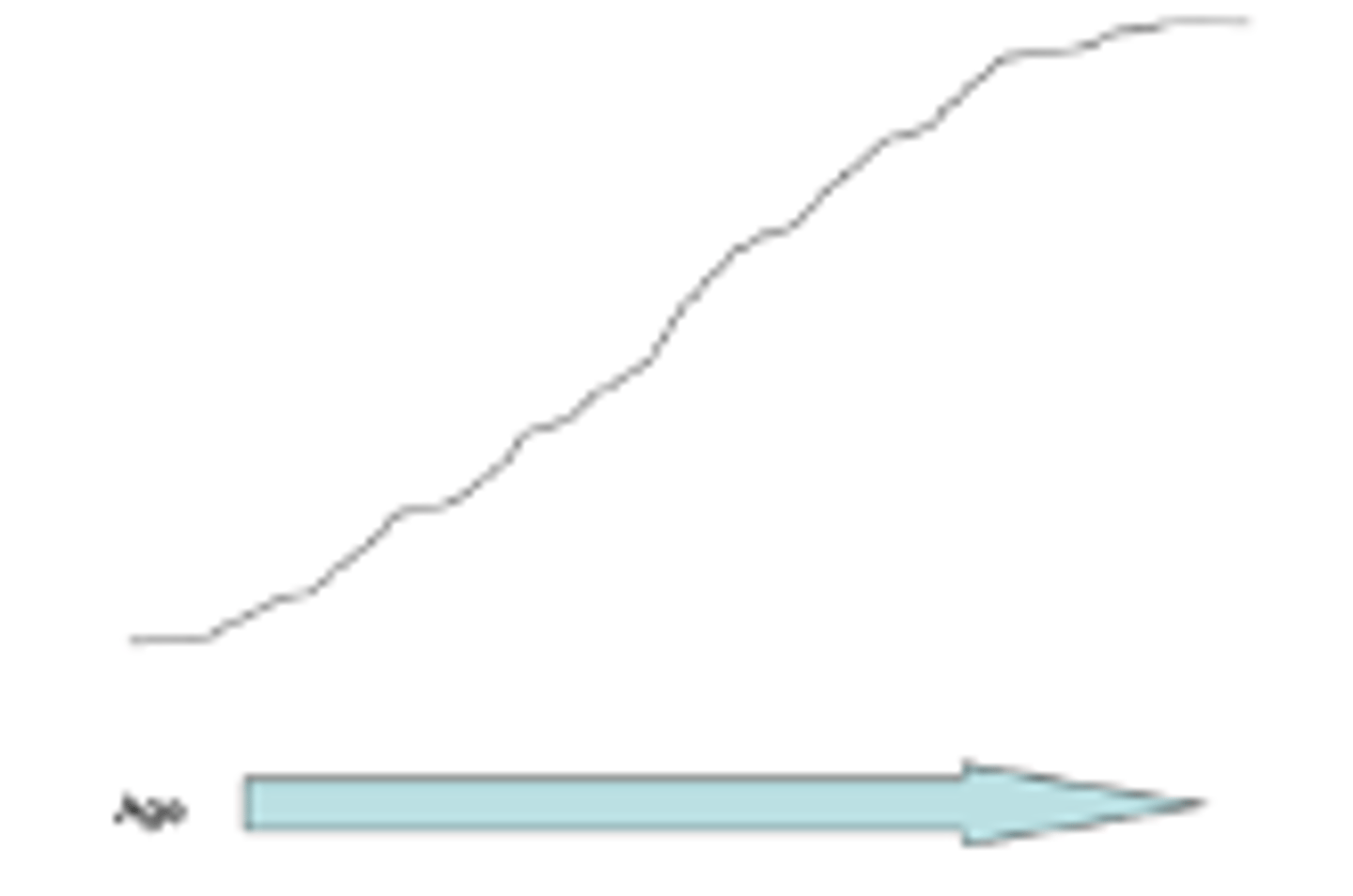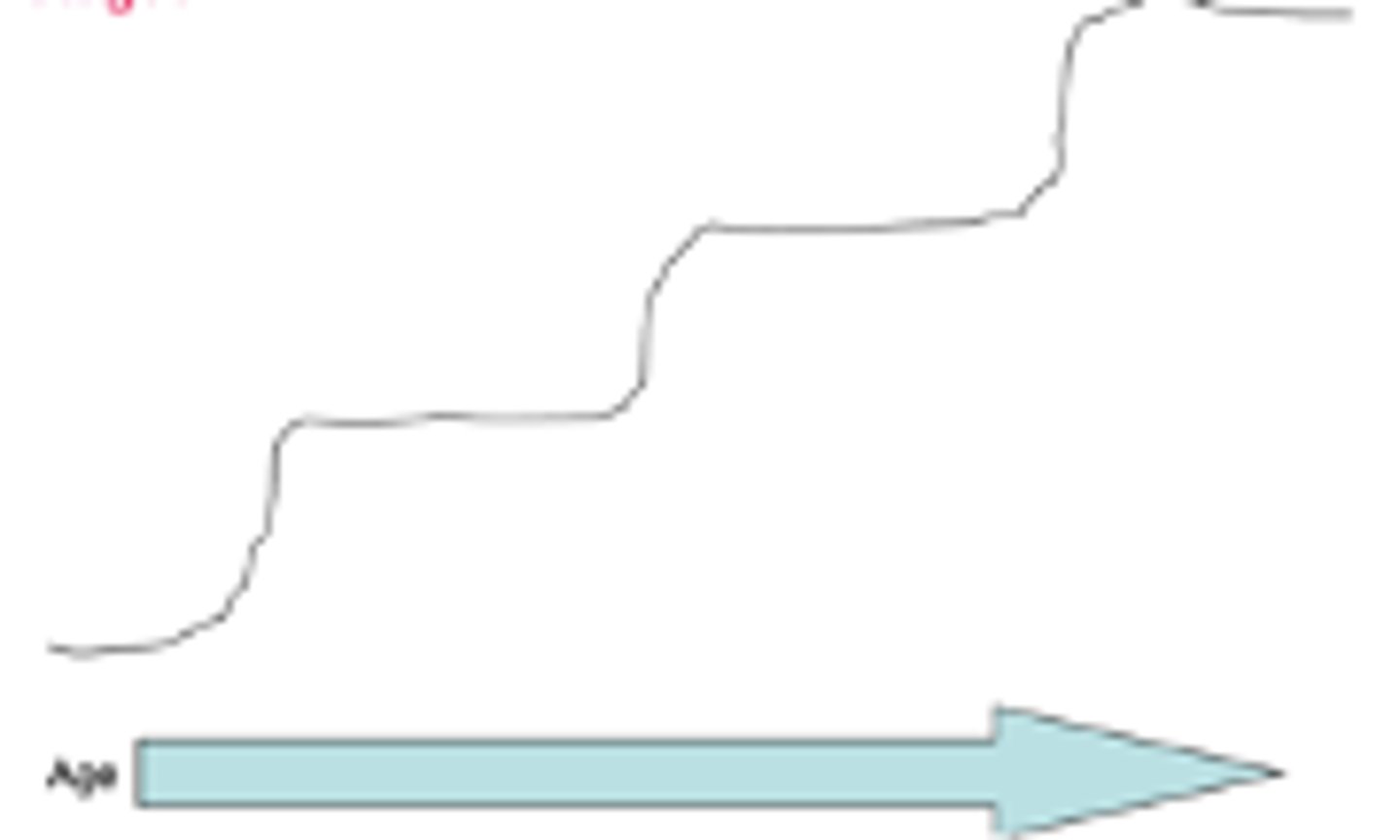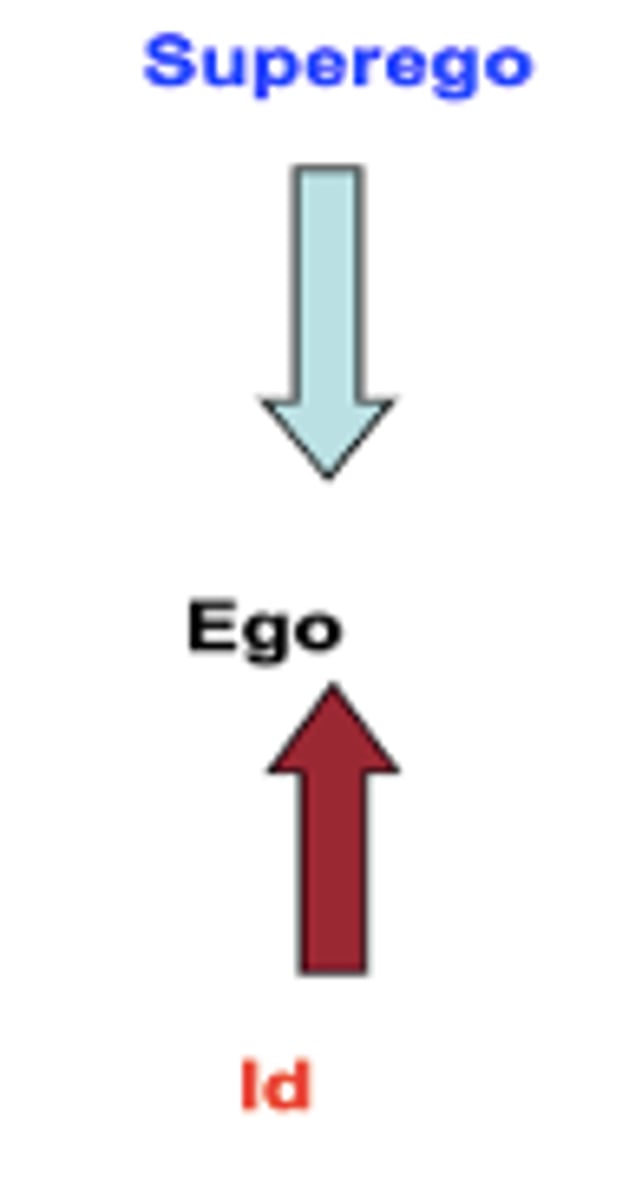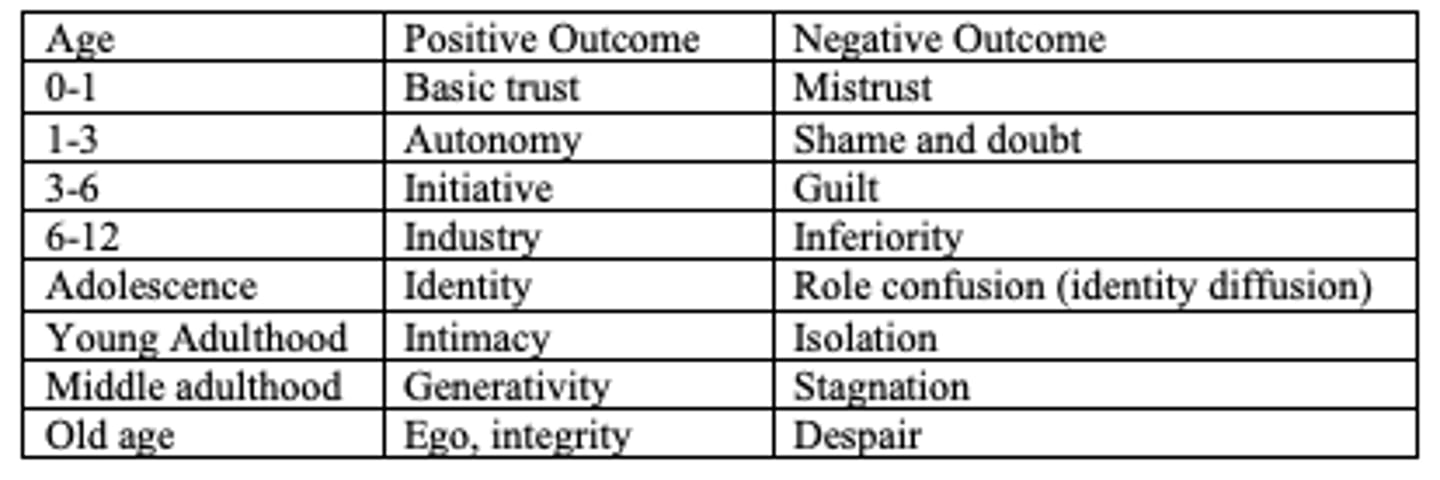PSY:3030 Social and Personality Development Exam 1
1/312
There's no tags or description
Looks like no tags are added yet.
Name | Mastery | Learn | Test | Matching | Spaced |
|---|
No study sessions yet.
313 Terms
What are the 5 questions of Developmental Research
1. What is the nature of the child?
2. What drives development?
3. What is the child's role in development?
4. How does development progress?
5. Can we tell the future from the past
What is the nature of the child?
Evil: child requires socialization; innately evil
-- child is born inherently selfish
Good: child will blossom if given freedom; innately pure
-- bad outcomes result from something spoiling the child's experience
Blank Slate: child reflect individual history
-- reflect their socialization
-- child is neither good nor bad
What drives development?
nature and nurture
What is the child's role in development?
passive
-- top down approach
active
-- parents recognize that children direct a lot of momentum
both are important in development
-- parent influences child and child influences parents
How does development progress?
continuous
discontinuous
Continuous
cumulative effect
-- things happen gradually
-- child is the same person going through the developmental growth
-- assumes development is incremental --> traits build up slowly after time but the child remains the same

discontinous
stages
-- development is much more dramatic
-- something may happen at one stage but not the other
-- same child may completely transform by next stage; children act very differently in different stages

can we tell future from the past?
Yes: stable traits or significant experiences that carry forward, especially during the 1st year
-- predicting from the past may be done in different ways
No: situational specificity
Major theories of development
classical
-- psychoanalytic (Freud, Erikson, contemporary neopsychoanalysis)
-- learning (Watson, Skinner, Bandura)
-- cognitive (piaget)
recent
-- biological (ethology, behavior genetics, temperament)
-- ecological (Bronfenbrenner, Belsky)
Psychoanalytic theorist
freud and erikson
learning theorist
watson, skinner, bandura
cognitive theorist
piaget
ecological theorist
bronfenbrenner, Belsky
Methodology
How data are gathered
How development change is captured
How studies are designed
how is data gathered?
Reports: questionnaires, structured interviews, narratives, and clinical interviews
observational methodologies
biological measures
how developmental change is captured?
cross-sectional designs, longitudinal designs, or combination of both
how are studies designed (control/manipulation of variables, randomization)?
correlational or experimental designs
Positives and negatives of Questionnaires/structured interviews
Positives (+): quick, cheap, easy, standard
Negatives (-): validity problems (people sometimes say one thing and do another)
-- however, many new report instruments have been extremely carefully developed and are successfully used for research and clinical, diagnostic purposes
Examples of questionnaires/structured interviews
Example: child symptom inventory --> Parent, teacher, and self-versions
Example: Dominique/Dominic --> child is shown vignette of symptoms (Dominique gets upset easily, do you?), child then answers if they are like him/her
-- Good instrument that produces good valid scores for internalizing and externalizing problems
Positives and negatives of clinical interviews
Positives (+): rich data, insights into individual differences, flexibility; Often useful with young children
Negative (-): time-consuming, not standard, hard to compare (however, many new clinical interviews are time-efficient and highly standardized)
Example: Dominic interview for children
New clinical interviews are?
efficient and highly standardized.
Narratives
def: a hybrid between observations and clinical interviews
-- they help combat the negatives of clinical interviews because kids can enact their thoughts and feeling
-- Dominic Interview is a version of that.
-- typically use these once children hit the age of 3
Narrative example
Child is given props and a story
-- story says the prop child isn't supposed to eat the hot soup but does, the child in the study is then asked what happens next --> does the parent discipline the child or does the parent care for the child?
-- this can give information on attachment perspectives
Naturalistic observation: positives and negatives
Positives (+): ecologically valid, “real” behaviors, rich data
-- Can sit in a playground or classroom and watch what occurs
Negatives (-): few rare behaviors seen
-- Examples: misbehavior, harsher parenting, empathy, etc.
Example: observing a child’s “free-flowing” behavior in classroom
Structured observation: positives and negatives
Positives (+):
-- Ecologically valid “real” behaviors, rich data
-- way to see more rare behaviors
-- Standardized environments that allow for comparisons across participants (e.g., snack, play, mishap)
-- Targeted behaviors can be elicited and seen
---- Give child a toy that will break --> child is lead to believe they broke the special object --> we can observe guilt
Negatives (-): older children’s behavior may be altered
Example: observing mother and child in standard contexts in lab or home
What is a problem with observations?
In the past, observations used to create difficulties with reliable coding --> those have now been remedied by modern videotaping techniques and a whole new science of reliability
Examples of biological measures
Molecular genetic measures (e.g., 5-HTTLPR polymorphism, gene associated with the serotonergic system)
Psychophysiological measures (skin conductance, heart rate)
Brain imaging measures (structural)
Brain activity measures (functional)
Neurotransmitters
Hormones
"Astronaut Training" --> Assessment of Electrodermal Reactivity.
EEG
Cortisol collection
Cheek swab (for genetic analyses)
What is the gold standard for research?
a multi-method approach that heavily favors observation, complemented by biological measures and reports.
What is a cross-sectional design and its benefits/cost?
def: collect data from children of different ages (e.g., observe 4-year-olds, 6-year-olds, 8-year-olds, 10-year-olds, 12-year-olds)
Positives (+): quick (in principle, could be done in one day), cheap
Negative (-): provide no data on the development of individual children
-- Can’t answer the question: can you predict the future from the past
Example: want to measure how memory changes over time
What is a longitudinal designs? benefits/cost
collect data from the same children repeatedly over time (e.g., observe at age 4, 6, 8, 10, and 12)
Positives (+): provide data on the development of individual children, their trajectories over time
Negatives (-): take “real time” (for example, from age 4 to 12 --> 8 years), very expensive
ex: examining a child from 7 months to 12 years old
Cross-sectional/longitudinal design
collect data from different cohorts repeatedly over time (e.g., recruit 4-, 6- and 8-year old's, and observe every 2 years for 4 years - at 6, 8, and 10, and at 8, 10, and 12): combine advantages of both
How studies are designed: Are variables controlled and manipulated; is a random assignment used?
NO: correlational designs
YES: experimental designs
correlational design
variables are not controlled or manipulated and random assignment is not used
experimental designs
variables are controlled and manipulated, random assignment is used.
Major theories of approaches to development
(1) PSYCHOANALYTIC (FREUD, ERIKSON)
(2) LEARNING (WATSON, SKINNER, BANDURA)
(3) COGNITIVE (PIAGET)
(4) BIOLOGICAL (ETHOLOGY, BEHAVIOR GENETICS, TEMPERAMENT)
(5) ECOLOGICAL (BRONFENBRENNER, BELSKY)
What were two things that freud's psychoanalytic theory were not?
not based on empirical data and not based on experiments. he used his clinical work.
Freud's Theory was
a comprehensive metaphor or model of personality development that grew out of Freud's clinical work with individual patients, based mostly on the analysis of free associations, dreams, slips of tongue, and other unconscious behaviors (defense mechanisms)
What were the driving forces of personality according to Freud
Two powerful biological instincts
-- eros & thanatos
the role of socialization
Eros
means life
-- the positive life staining factors like eating, sex, respiration, bodily needs
Thanatos
means death
-- destructive behavior like aggression, masochism
what is the role of socialization in personality for Freud?
to harness, control, and channel the basic biological instincts of eros and thanatos.
Because of a clash of biology and culture....
a complex personality system emerges in the course of development.
What are the 3 personalities?
id (basic) ego(median) superego(max)

Three pirnciples
perfection principle
reality principle
pleasure principle
what principle is Id?
pleasure principle: passion, instincts, emotions, wants
-- seeks immediate gratification
-- impulsive
-- primary, inborn, unconscious
what principle is ego?
the reality principle: seeks realistic and acceptable ways to easily satisfy the Id (delaying, planning, modifying impulse)
-- deliberate, conscious, rational
-- ex: having to drive to grocery store for food
what principle is super ego?
perfection principle: internal censor; conscience
-- ought not, should not
-- judgement
-- internalized standards, guilt
Major driving force of personality development according to Freud
conflicts between biological needs (Id), and society's dictates
How many stages does Freud's psychosexual development have?
5
-- stages depends on where in the body psychosexual energy focuses
What are the 5 stages of the psychosexual development model? stage/age
0-1 the oral stage
1-3 the anal stage
3-6 the phallic stage
6-12 the latency stage
12+ the genital stage
Oral stage
0-1
-- seek satisfaction
-- babies explore their world with their mouth
anal stage
1-3
-- first stage of conflict with parents because they want to start controlling themselves. ex: bathroom habits (potty training)
-- first sign of expectations (you will control your behavior)
phallic stage
3-6
-- where superego is created
-- Battle with sexual desire with parents and then realizes their place in the family.
A boy's sexual desires focuses on
the mother --> hostility toward the father --> increase anxiety --> repression of the desire, identification with the father, adoption of his values, emulating father (superego)
Latency stage
6-12
-- child has conscious super ego.
genital stage
12+
-- sexuality and other sexual feelings emerge
What happens if these needs aren't met at each stage?
fixation and other defense mechanisms
-- lack of defense mechanism
-- what happens in these stages affect us later.
Defense mechanisms
Strategies the mind adopts actively to deal with anxiety, tension, threatening or unacceptable thoughts and emotions. The mind plays an active role in coping, rather just passively reflect reality
What are the 5 defense mechanisms?
repression, projection, denial, rationalization, regression, reaction formation, sublimation
all driven by unconscious force
Repression
remove threatening thoughts from awareness
Projection
attribute unacceptable impulses to others
Denial
refuse to recognize a threatening situation or thought
Rationalization
give a "reasonable" explanation for an event
regression
return to a less mature behavior
reaction formation
express the very opposite of disturbing ideas
sublimation
channeling unacceptable impulse to socially acceptable outlets
does the mind take an active or passive role in coping?
takes an active role in coping rather than just passively reflecting reality.
Genius of Freud
Showed us the child we had not known; revolutionized our thinking about human nature and psychological functioning
Showed us that things may not be what they seem, and that one may have to go beyond the obvious
Proposed the first system approach to personality and its development
Was the first to emphasize the power of affect
Was the first to underscore the importance and complexity of early affective experience
Proposed the existence and importance of the unconscious processes; showed how the mind actively copes with anxiety -- does not simply reflect, but transforms internal and external world
Inspired many followers in psychology and the humanities
Was the first to emphasize that early relationships are critically important and are carried forward
Proposed the first theory of conscience; stressed guilt and fear as key affects
Finally, generated a wonderfully interesting and exciting metaphor of development and psychological functioning
But: a lot of problems … the methods not objective, mostly case studies, retrospective reports. Difficult to verify empirically; when empirical research was attempted, it usually failed to support the theory
Freud vs Erikson: Nature of child
Freud: evil; original sin; "seething cauldron"; driven by the unconscious
Erikson: good; rational adaptive
Freud vs Erikson: Driving Force of Development
Freud: nature/culture clash
Nature and its conflict with nurture
Erikson: nurture; culture and developmentally changing psychosocial tasks
Freud vs Erikson: Child's role in development
Freud: passive recipient
Erikson: active explorer
Freud vs Erikson: Course of Development
Freud: 5 stages (psychosexual)
Erikson: 8 stages (psychosocial crises)
Freud vs. Erikson on future prediction
Freud: yes (e.g., fixation at an earlier stage; mother-child relationship is a prototype of future love relationships)
Erikson: yes (if a crisis is not resolved successfully, it has lasting consequences for development)
Freud vs Erikson: Important agents
Freud believed parents were while Erikson believed in multiple agents of socialization (parents, peers, teachers, friends, lovers, spouses)
Freud vs Erikson: developmental scenario
Freud was 0 to adolescence while Erikson was our entire life span.
According to erikson, what did each crisis have?
Is tied to developmentally changing important life tasks
Has a potential for adaptation/growth or maladaptation/failure
Sets the stage for future development
Centers around different significant events, social influences, agents
Erikson's view
completely consistent with contemporary developmental psychopathology
what are the 8 crisis for Erikson?
basic trust vs mistrust
autonomy vs shame and doubt
initiative vs guilt
industry vs inferiority
identity vs role confusion (identity diffusion)
intimacy vs isolation
generativity vs stagnation
ego integrity vs despair

Basic Trust vs Mistrust
age 0-1
-- learning to trust our parental figures
autonomy vs shame and doubt
1-3
-- whether or not we have to ask to do things
initiative vs guilt
3-6
-- try different things; different family roles
-- am i good or bad child?
industry vs inferiority
6-12
-- am i successful or inferior to my peers
-- concerned with roles outside of the home
identity vs role confusion
adolescence
-- who am i?
intimacy vs isolation
young adulthood
-- sharing my life with another person or stay alone --> marriage or friendship
generativity vs stagnation
middle adulthood
-- how am i doing in all my roles?
-- how do I feel about my roles?
ego integrity vs despair
old age
-- reflect on their lives. do I have any regrets. feeling useful still.
Appraisal of Erikson's Theory
Important shift from unconscious sexuality to rationality
Child: not a passive recipient of socialization, but an active explorer in life’s journey
Development not ending in adolescence; stretching over the life span
A compelling notion of developmental tasks that have a potential for both strength and vulnerability
Rich social context of human life stressed, including many social niches beyond Freudian bedroom and bathroom
Continued a systematic approach: earlier stages incorporated in later stages
The importance of the quest for individual identity
Intuitively appealing
BUT:
-- Uncontrolled, non-objective methods
-- Vague as to the specific mechanisms of the developmental transitions
Who was a part of the learning approach for development
Watson, Sinner, Bandura
learning
change in behavior
1. The child thinks, perceives, reacts in a new way
2. This change results from experience (not maturation, heredity, injury)
3. This change is relatively permanent
what are the processes of learning and who did them?
1. Repetition Watson
2. Classical conditioning (new response acquired via association of a neutral stimulus with one that already elicits the response) Watson
3. Operant conditioning (freely emitted response reinforced by its consequences) Skinner
4. Observational learning Bandura
Watson Learning Model
radical behaviorism in the 20s
-- child is shaped by parent environment
-- repetition and classical conditioning.
Skinner Learning Model
50-60s
operant conditioning
positive and negative reinforcers
Bandura Learning Model
70s and current
cognitive social learning
most important: observational learning (modeling and imitation)
emphasis on cognitive learning
what does bandura's cognitive social learning theory say about children and their learning?
children are active and thinking contributors to their own learning
-- they choose to which models to attend and what to imitate
bandura cognitive social learning theory: how are new behaviors acquired?
Although classical and operant conditioning do take place, they are incredibly inefficient ways of learning.
Watching and imitating models: Much more efficient
-- cognitive social learning, vicarious reinforcement
Cognitive social learning
Child can learn without ever having performed an act, simply by watching models (child attends, encodes, stores information)
vicarious reinforcement
Child does not need personally to experience reinforcements - it's enough to see consequences of acts for the model
Bandura believes that children can learn..
children can learn without ever having performed an act, simply by watching models
imporant reinforcements for Banduras cognitive social learning theory
self generated good feelings, mostly feelings of self efficacy.
Learning theory: Appraisal - positives
Very precise, testable hypotheses
Explains a substantial proportion of how new behavior is acquired and maintained (for example, aggression)
Useful clinical applications (therapies, behavior modification); instrument of social change (Bandura's TV work in Africa)
Bandura: the move to the level of cognitive representation was quite revolutionary